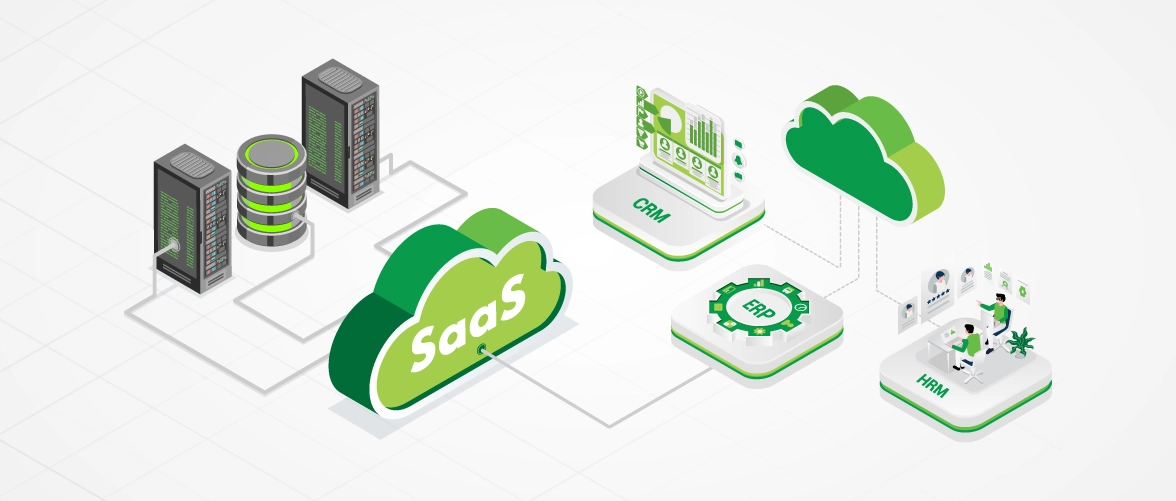Popular SaaS Solutions & Their Applications
26 Apr 2024

The popularity of SaaS solutions has grown massively in recent years, with both large and small businesses embracing modern technologies. Understanding the various types of SaaS solutions is essential for selecting the best solution for a company. SaaS is the most popular type of cloud computing service and the top layer of the cloud computing pyramid.
This blog focuses on the most common type of SaaS solutions and how they can benefit businesses, particularly small and medium-sized enterprises.
Before anything, let’s first know SaaS & its benefits
SaaS (Software as a Service) is a subscription-based model for delivering software/services over the internet. In contrast to on-premises and traditional software, which require users to be physically present in a specific location, SaaS software can be accessed from anywhere using almost any device. SaaS providers either develop their own solutions or resell solutions developed by others, charging customers on a recurring basis.
The following are the key advantages of utilising SaaS solutions:
Instant access from any location
Instant and improved scalability
Flexible and scalable compared to on-premises solutions
Agility in operation
There is no need to invest heavily in the underlying infrastructure.
Businesses do not have to worry about maintenance, upgrades, or keeping services running on their own.
There have significantly lower upfront costs.
In most cases, feature updates and security policies are implemented automatically.
Popular Types Of SaaS Solutions
Here we will discuss some of the most popular and widely-used SaaS solutions across various sectors.
CRMs
Customer Relationship Management solutions automate sales and marketing processes and can be crucial for growing companies. These systems enable businesses to build and maintain strong business relationships while also responding to queries and complaints in a timely manner. CRMs enable businesses to stay in touch with their customers by managing customer profiles and providing a more personalised experience.
A CRM collects customer information and tracks interactions across multiple channels, such as the website, support logs, customer reviews and feedback, and social media.
ERPs
ERP software is typically geared toward enterprises and large organisations, allowing them to manage their business processes in real-time. ERPs improve customer satisfaction and, as a result, revenue. Procurement, accounting, risk and project management, supply chain, budgeting, and compliance are some of the key areas covered by ERP. These solutions reduce the possibility of data duplication by providing a single source of up-to-date and accurate information.
Project Management Solutions
Managing projects necessitates constant updates, which can quickly become a problem if traditional solutions are used. Using SaaS PM software, information is always up to date and available in real-time, allowing team members to make informed and timely decisions.
The cloud-based solutions provide the following advantages inherent in cloud computing:
Teams that are linked, with access from anywhere
Reliable access without the need for team members to locate and send the latest versions of documents.
Lower initial costs
Low maintenance so that teams can concentrate on project management rather than technical aspects
greater adaptability
Security and disaster recovery are built in.
Simpler installation and automatic feature updates/security patches
HRM Solutions
SaaS HR systems are designed to digitise HR processes, are easily implemented, and are highly scalable. For example, a company hiring new employees may want to add an LMS (Learning Management System) quickly, which is not a problem when using scalable SaaS solutions. The feature set varies depending on the provider, but the following are essential components of an HRM system:
Tracking of applicants
Recruiting
Pre-screening and interview scheduling
Job posting on a job board
Management of attendance and leave
Compliance
Development and learning
Forms, notices, and announcements
Management of performance
Reporting
Performance evaluation system for employees
Summing Up!
The acceptance of the SaaS delivery model by small and medium businesses has steadily increased demand for SaaS solutions.
Many reputable software companies have already shifted to the new model, indicating the likely future path for businesses of all sizes.
Cloud computing and SaaS solutions can be game changers for businesses, particularly SMBs and growing businesses looking to scale up. Leveraging existing data improves operational efficiency and enables businesses to meet customer expectations. Technology has levelled the playing field, allowing SMBs to access technologies that were previously reserved for large enterprises.